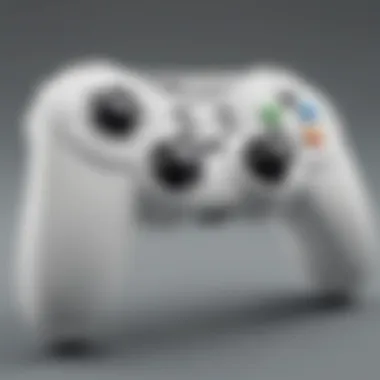Exploring the Legacy of Nintendo Wii U Games


Intro
The Nintendo Wii U serves as a unique chapter in the storied history of gaming consoles. Launched in 2012, it was a bold step for Nintendo designed to bridge the gap between traditional gaming and the modern landscape powered by innovation. However, it also found itself wrestling with its identity, not merely as an extension of the successful Wii but as a console that could offer something truly distinct. Within its catalog lies an extensive library of games that not only shaped player experiences but also explored the boundaries of game design and interactivity. This narrative seeks to peel back the layers of the Wii U's offerings, examining standout titles, gameplay experiences, and the challenges this console faced amidst fierce competition.
Overview of Wii U Games
The Wii U's game library is a kaleidoscope of ideas, showcasing a spectrum from engaging family-friendly titles to intricate narrative adventures. Each game reflects the console’s dual-screen setup, relying heavily on the unique functionality of the GamePad. This innovation brought about new methods of gameplay, where players would sometimes interact with the main screen while viewing necessary information on the GamePad. The result was a platform that promoted cooperative play in ways previously unexplored.
Games like Super Mario 3D World showcased the fun of multiplayer gaming, making every player feel engaged, regardless of their skill level. Others, like Bayonetta 2, pushed the limits of what was visually and mechanically possible, all while enveloping players in narratives that resonated.
In short, the extensive range of games reflects an ambition that attempted to marry nostalgia with fresh ideas, bringing both longstanding fans and newcomers into the fold.
"The Wii U represents not just a console's evolution but an experiment in creativity and storytelling. While it faced hurdles, its games are worth exploring for their artistry and innovation."
Highlights of Standout Titles
- Super Mario 3D World: A delightful platformer that elevated cooperative play, featuring innovative level design and engaging power-ups.
- The Legend of Zelda: The Wind Waker HD: An updated classic, revitalizing a beloved title with enhanced visuals and gameplay mechanics.
- Splatoon: A fresh take on the shooter genre which replaced bullets with colorful ink, creating a vibrant, competing environment.
- Mario Kart 8: Building on its predecessors, it introduced new mechanics and spectacular visuals, plus the adrenaline of online racing.
These titles not only defined the Wii U experience but left a lasting impact on the gaming culture.
Challenges and Legacy
Though the Wii U attempted to carve out its niche, it faced many challenges. Its marketing missteps led to significant confusion about its capabilities compared to the original Wii, causing consumers to overlook its potential. This resulted in lower sales numbers, limiting its reach in the gaming community.
Despite these struggles, the legacy of the Wii U is complex. Many of its games have continued to shine on newer consoles, affirming their value beyond the hardware they were originally associated with. They serve as critical stepping stones in game design, influencing how developers approach creativity and innovation.
In retrospect, the Wii U’s game library offers insight into broader trends within the gaming industry. Its unique approach to gameplay and design contributed to a richer understanding of what interactive entertainment could be.
As we proceed through this exploration of the Nintendo Wii U’s offerings, we will delve deeper into specific titles, assessing their narratives, characters, and visual elegance. The discussions ahead promise to reveal insights for avid gamers and curious minds alike.
Prologue to Nintendo Wii U Games
The Nintendo Wii U holds a unique place in the gaming world. Introduced as the successor to the highly successful Wii, it aimed to expand upon the innovative concepts that the original console had established. However, the Wii U brought a mixed bag of reception, which makes its game library one that's rich with contrasts—offering both triumphs and missteps in game design and audience engagement.
When we talk about the importance of Nintendo Wii U games, it’s crucial to consider how they reflect broader shifts in gaming alongside technological advancements. The games developed for this console didn't just entertain; they served as a canvas for creativity and experimentation—two pivotal traits when assessing the legacy of gaming systems.
In laying out the characteristics of Wii U games, one must address several critical elements:
- Innovative Gameplay: The unique blend of traditional console gaming fused with touch-screen interactivity through the GamePad opened the door for imaginative gameplay mechanics.
- Community Engagement: Many titles encouraged cooperative play and community interaction, a shift from the solitary gaming experiences of the past.
- Preservation of Legacy: Several games were remastered versions of beloved classics, fostering nostalgia while introducing them to a new generation of players.
This article seeks to dissect these various components. With a focus on both the highlights and the underwhelming offerings, we will explore not only the technical aspects but also the cultural implications of the Wii U's library. Understanding the context of its games can offer valuable lessons for developers and players alike. Like the ever-expanding universe of gaming itself, the world of Wii U games is both intricate and fascinating, deserving of admiration and scrutiny alike.
Overview of the Wii U Console
The Wii U was Nintendo's attempt to usher in a new era of gaming that combined the simplicity of gaming controls with deeper, more immersive experiences. At its core, the Wii U was an 8th generation console that featured both traditional and novel gaming options.
One standout aspect was the GamePad, a controller that featured a 6.2-inch touch screen with motion controls. This device allowed for dual-screen gameplay, encouraging developers to reimagine how games were structured. For example, during multiplayer sessions, one player could view their game on the TV, while another could utilize the GamePad’s unique screen.
The aesthetic design of the console was also noteworthy. With its sleek black or white exterior, it was intended to fit in with modern home entertainment systems. Despite its technologically forward stance, the Wii U struggled with some performance issues, particularly when compared to competitors in the same generation.


The Context of its Release
Launched in November 2012 in North America, the Wii U stumbled out the gate for several reasons. The competitive landscape was shifting rapidly; with the rise of mobile gaming and the impending release of the PlayStation 4 and Xbox One, many consumers were hesitant to embrace a new Nintendo console.
Moreover, there was some confusion over the identity of the Wii U itself. Many potential buyers mistakenly thought it was an accessory for the original Wii rather than a completely new system. This lack of clarity hindered sales at launch, causing it to be overshadowed in the gaming market.
Despite these challenges, the potential for the console was visible. The early titles released showcased a rich blend of innovation and nostalgia. Games like Nintendo Land tried to illustrate the possibilities of the GamePad, building mini-games that highlighted its capabilities. Meanwhile, titles like New Super Mario Bros. U drew on the platforming legacy that Nintendo had carefully cultivated over decades.
In summary, the Wii U’s debut was not just about a new console but rather a statement on where gaming was heading. While it couldn't completely capitalize on its promises due to various external and internal factors, its legacy within the context of gaming history remains noteworthy.
Key Features of Wii U Games
The Nintendo Wii U was a console that tried to breathe new life into the gaming industry with some notable innovations. Its key features not only defined the games that came with it, but also influenced how gamers interacted with their play experiences. Understanding these aspects is crucial to fully grasping the Wii U's impact on both game design and the community around it.
Dual Screen Functionality
At the heart of the Wii U's gameplay experience lies its dual screen functionality. This feature stems from the unique combination of the TV screen and the Wii U GamePad. The GamePad acts as a second screen, allowing for richer, more immersive gameplay. Gamers could use the GamePad for inventory management, map navigation, or even as a dedicated display for mini-games. In titles like ZombiU, the GamePad turned into a handy tool, offering a sense of urgency and tension. Players had to glance down, all while fending off zombies in real-time on their TV, immersing them in an atmosphere that heightened the stakes.
Moreover, the dual screens allowed for asymmetric gameplay, where players could have different roles in the same game environment. For example, in Nintendoland, one player could be using the GamePad to track movements while others might play on the television. This promoted a sense of camaraderie and competition, defining how parties would engage in multiplayer settings.
"The Wii U’s dual screen functionality redefined local multiplayer games, turning them into shared yet distinct experiences."
GamePad Innovations
The Wii U GamePad was not just another controller; it was a breakthrough tool in game interaction. Its touchscreen added layers of complexity that changed how games were played. With the sleek design and built-in gyroscope, it provided unique input options, making controls more intuitive.
Games like Mario Kart 8 utilized the GamePad in ways that enhanced user engagement. Players could manage items, look back in the race, or even have a unique perspective while playing. This interactivity created deeper gameplay mechanics and allowed players to feel more in control, as they had a variety of options right at their fingertips.
Additionally, the ability to play games off the TV screen made the Wii U stand out. Gamers could continue their adventures in The Legend of Zelda: The Wind Waker HD without hogging the television, truly democratizing gaming at home. It allowed for a more fluid integration into day-to-day life, making gaming accessible whenever and wherever.
In summary, the Wii U's key features—the dual screen functionality and the innovative GamePad—reshaped player expectations and standards in the gaming world. These features not only enhanced the individual gaming experience but also influenced how designers approached gameplay mechanics, paving the way for future consoles and their subsequent offerings.
Notable Titles in the Wii U Library
The Nintendo Wii U library may not be as vast as its contemporaries, yet it holds gems that changed the gaming landscape and shaped player experiences in profound ways. Each title offers a unique contribution, whether it's through innovative mechanics, astonishing graphics, or engaging narratives. Within this section, we’ll take a closer look at some standout games that not only define what the Wii U represents but also highlight the console's potential.
Super Mario 3D World and its Design Elements
Super Mario 3D World strikes a chord for many gamers, encapsulating what made Nintendo a household name. Released in 2013, it pushed the envelope with its vibrant levels and introduced new gameplay mechanics like the Cat Suit, which allows players to climb walls and scratch enemies. Its emphasis on cooperative gameplay broadened its appeal, allowing up to four players to join forces, creating a dynamic that felt fresh yet familiar. The design elements blend a captivating art direction with clever level layouts, encouraging exploration and creativity in gameplay.
"Super Mario 3D World redefined the platforming genre by seamlessly incorporating cooperative play into its design, making it a must-play for friends and family alike."
Each stage feels like a crafted experience, with attention to detail that rewards skilled playing, but also ensures newcomers can enjoy the ride.
The Legend of Zelda: The Wind Waker HD
Bringing back the magic of The Legend of Zelda: The Wind Waker, the HD remaster, which released in 2013, meant something beyond nostalgia. It took the original's stunning cel-shaded graphics and brought them to life on the Wii U, enhancing visual fidelity while improving on gameplay elements. The open-sea exploration felt more engaging thanks to adjustments in mechanics, and the GamePad offered unique gameplay integrations, such as the map and inventory management. It’s not just a remaster; it’s a love letter to fans that also attracts newcomers.
Much discussion has centered around its quest structure and portrayal of Link’s journey. Its emphasis on exploration without rushing players highlights the core philosophy behind the series—adventure at a leisurely pace.


Splatoon: Redefining Multiplayer Gaming
The emergence of Splatoon in 2015 startled many in the gaming community. It shattered the typical mold of shooter games, which often leaned toward realism. Instead, Nintendo offered a colorful, ink-splatting alternative. With its innovative take on team-based gameplay, players transformed into squids that could swim in ink and splatter opponents, changing the direction of multiplayer gaming.
The emphasis on strategy—controlling territory rather than simply eliminating opponents—was a refreshing twist. The game's success went beyond its mechanics; it fostered a competitive community that thrives online while celebrating the fun of teamwork and coordination.
Mario Kart and the Evolution of Racing Games
When Mario Kart 8 launched in 2014, it was clear it wasn't just another racing game. The blend of exhilarating speed, intricate track designs, and the introduction of anti-gravity sections gave players a fresh perspective on what racing could be. It perfectly harnessed the strengths of the Wii U’s hardware, pushing graphics and player count to new limits, allowing for chaotic gameplay that felt balanced yet unpredictable.
The addition of DLC and innovative battle modes extended the game's life, aligning with modern gaming preferences. Each race offers familiarity yet unpredictability, a hallmark of the franchise. Plus, its in-depth options for customization made it more accessible to a wider audience.
In reflection, these notable titles illustrate the inventive spirit of the Wii U. They showcase powerful storytelling, aesthetic creativity, and a profound contribution to game design. Each game, in its unique way, carved a niche in the gaming world, ultimately cementing the Wii U's place in history.
Game Development for the Wii U
The development of games for the Nintendo Wii U was a multifaceted journey filled with unique challenges and breakthroughs that shaped the overall landscape of gaming during that era. It’s essential to understand the various facets of game development in relation to this console. The ability of developers to navigate these waters influenced not only the quality and popularity of titles but also their technical advancements, economic viability, and their contribution to gaming culture.
Challenges Faced by Developers
Game developers faced a myriad of obstacles while creating titles for the Wii U. One of the primary challenges was adapting to the console's dual-screen functionality, which, while innovative, required significant redesign of traditional gameplay mechanics. This was especially true for studios that were accustomed to working solely with conventional gaming controllers. Notably, developers had to rethink UI (user interface) strategies and integrate it seamlessly with the GamePad.
- Technological Limitations: The Wii U was perceived as not being as powerful as its contemporaries like the PlayStation 4 or Xbox One. This necessitated compromises in graphics quality and processing power, challenging developers to be creative with their design choices.
- Market Positioning: With the Wii U entering a gaming market already populated by established consoles, developers battled to attract an audience. The uniqueness of the console didn’t always translate into immediate sales, making it hard for studios to secure funding for projects.
The combination of these obstacles required developers to employ an innovative mindset. Many were forced to rely on their creativity, often leading to unexpected gameplay styles. For instance, titles like Splatoon revolutionized multiplayer shooter dynamics despite the constraints, demonstrating how developers turned challenges into opportunities for creative gameplay.
Technological Innovations and Limitations
While developers had to grapple with the Wii U’s limitations, they also harnessed innovative technology to push boundaries within gameplay. The GamePad introduced a second screen that allowed for a richer gaming experience, making it possible to present information in new ways.
Innovations:
- Asymmetric Gameplay: This concept allowed one player to have a different perspective on the game, creating engaging multiplayer experiences. Games like Nintendo Land showcased how a player with the GamePad could interact with the game world in ways not possible for others with traditional controllers.
- Touch Controls: Integrating touch controls opened new avenues for gameplay. Titles such as Zelda: The Wind Waker HD provided players with unique functionalities that enhanced navigation and combat.
Limitations:
- Performance Issues: The limitations in processing power compared to other platforms often resulted in lower frame rates and delayed responses in some games. Developers committed to optimizing performance while delivering a rich visual experience, but this was often a balancing act.
- Market Penetration: With the eventual decline in sales, many smaller studios hesitated to develop exclusively for the Wii U, fearing that their potential player base would be minuscule.
The Impact of Wii U Games on Pop Culture
The Nintendo Wii U, while it often stands in the shadow of its successor, has made a mark on pop culture that cannot be underestimated. This console brought with it a unique blend of creativity and innovation, and the games developed for it forged connections between players that transformed not just the gaming experience but also how people interact with games and each other. Games like Splatoon and Super Mario 3D World contributed to the construction of a community and presented fresh mechanics that would resonate across platforms.
Influence on Game Mechanics
One cannot stress enough how the Wii U game library shifted traditional game mechanics. When New Super Mario Bros. U made its debut, it wasn't just a nostalgic trip down memory lane; it introduced players to the concept of cooperative gameplay where someone could join a level mid-game, dusting off the conventions around single-player experiences. This attribute allowed players to jump in and out without a hitch, encouraging social play.
Moreover, the GamePad component introduced by the Wii U changed the status quo. It wasn't just another controller; it provided a secondary screen that offered innovative ways to engage with games. Many titles leveraged this technology creatively, such as ZombiU, which utilized the touchscreen to enhance gameplay realism.
- Key contributions to game mechanics include:


- Asynchronous gameplay: Players could engage with the game differently, manipulating the environment without needing to pause it.
- Zone creation: Titles like Splatoon offered maps and visual languages that encouraged players to form strategies while making their mark literally and figuratively with ink on the virtual battlefield.
The influence was palpable; developers outside of Nintendo noted these shifts and began to incorporate similar mechanics in their own titles. This cross-pollination between games opened the door for further exploration of interactive design that adhered to modern gamers' evolving preferences.
Creating a Community of Gamers
The sense of community built around Wii U games deserves close examination. The console's quirky titles not only entertained but also fostered a dedicated environment for players to share experiences. Games like Super Smash Bros. for Wii U became cultural phenomena, drawing friends to gather for tournaments and casual play. These sessions were not merely competitive but rather celebrations of shared experiences, with players bonding over moments of triumph or amusing blunders.
Social platforms saw an uptick in discussions and fan engagement. Players shared tips on Reddit, designed hand-crafted levels on Super Mario Maker, and showcased their creativity and strategies on YouTube. This vibrant ecosystem around the games bred a population of gamers who reveled in their community identity.
- A few notable outcomes of this community building include:
- Fan art and content: Inspired by beloved characters, players created artwork and videos to express their appreciation.
- Collaboration: Events like fan art competitions and online challenges further united gamers in shared creativity, showing how the love for a game can transcend mere play.
In summary, the impact of Wii U games on pop culture reinforces how this system catalyzed a shift in how gaming communities form, function, and thrive. The duality of online and offline interaction, mixed with innovative game mechanics, has left an indelible mark that continues to echo in the industry today.
"Gaming evolves, but those early connections forged with the Wii U set the stage for how we engage with games in modern culture."
Through an exploration of these themes, we gain valuable insight into how the Nintendo Wii U has contributed to the evolving narrative of gaming history.
Wii U's Legacy in the Gaming Industry
The Nintendo Wii U holds an intriguing place in the annals of gaming history. Even though it didn’t perform as commercially successful as its predecessor, the Wii, its contributions to the gaming industry carry a weight that can't be ignored. The legacy of the Wii U extends far beyond its failure to achieve the kind of widespread recognition that the Nintendo Switch has enjoyed. Instead, the Wii U laid the groundwork for innovative gaming experiences that other platforms would later adopt.
Transition to Nintendo Switch
First and foremost, the transition from the Wii U to the Nintendo Switch is a tale of evolution. The Wii U introduced a dual-screen setup with its GamePad, a concept that some may consider niche. However, this very concept paved the way for the Nintendo Switch’s hybrid model. Player feedback led Nintendo to refine and repurpose these concepts, resulting in a product that resonated broadly with gaming audiences worldwide.
The Switch didn’t just inherit the ideas from Wii U; it optimized them. While the GamePad was somewhat cumbersome, the Switch offered a more intuitive interface through its detachable Joy-Con controllers. This adaptability brought gaming from console to mobile, adopting a style that appeals to casual and hardcore gamers. It’s noteworthy to point out that while many doodled about the Wii U’s failure, it was crafting the mold for something spectacular with the Switch.
"The Nintendo Switch represents everything we wanted the Wii U to be, and more! It's the direct offspring of its ideas, but in a much more versatile package."
Lessons Learned from Wii U's Lifecycle
The lifecycle of the Wii U was replete with lessons, both for Nintendo and the broader gaming community. One primary takeaway is the importance of branding and communication. Many casual gamers were simply unaware of what the Wii U truly was, mistaking it for an accessory or upgrade to the Wii instead of a standalone console. This lack of clarity affected its market reach and sales profoundly.
Moreover, the failures and successes throughout its lifecycle taught developers a lot about audience engagement. Unlike the Wii, where title releases were often family-oriented and catered to a broad demographic, the Wii U embarked on a more mature direction, targeting core gamers with franchises like "Bayonetta 2" and "Xenoblade Chronicles X".
This shift highlighted a delicate balance; it showed that while innovation is key, so too is knowing your audience. Nintendo learned the hard way that the most sophisticated gaming experiences must still align with the expectations of their player base. In this sense, the Wii U's legacy serves as a cautionary tale, reminding developers of the significance of audience awareness as they innovate for the future.
Ultimately, the story of the Wii U is not one of failure but one of forging paths for the future. The lessons it imparted have undoubtedly shaped the current landscape of gaming, affecting not only Nintendo's strategic decisions but also influencing competitors in the industry. In retrospect, the Wii U's legacy illuminates the intricacies of gaming development, audience engagement, and the continuous journey of innovation.
Finale
As we draw this exploration of Nintendo Wii U games to a close, it’s clear that the Wii U holds a special place in the pantheon of gaming histories. While the console itself faced numerous utfordringer and setbacks throughout its lifecycle, the games it produced offered a unique blend of innovation, creativity, and nostalgia that won the hearts of many gamers.
Reflecting on the Wii U Experience
Reflecting back, the Wii U's game library symbolizes a curious chapter in gaming evolution. Titles like Super Mario 3D World or Splatoon not only entertained but introduced mechanics that would become staples in modern game design. The incorporation of innovative features, such as the GamePad's unique capabilities, provided a new way for players to engage with the gaming experience.
Importantly, the Wii U served as a bridge between the classic Nintendo charm and a new wave of online gaming culture. For many players, it wasn't just about completing levels or racing to the finish line; it was about forming connections with others through multiplayer experiences and community engagement. This console encouraged collaboration and competition in ways that would later be heightened by the Nintendo Switch.
In essence, the legacy of the Wii U extends beyond its commercial performance. It stands as a testament to Nintendo's commitment to innovation and creativity in gaming. While it may not have reached the sales numbers of its successors, the impact of the Wii U games is undeniable. They carved pathways for future developments in the industry, paving the way for mechanics and styles that resonate today.
"The Wii U may have stumbled, but its games left lasting footprints in the gaming landscape that are still felt even today."
In wrapping up this analysis, the sentiment around the Wii U is one of appreciation and respect. It tells a story of ambition, where risks were taken and new ideas were put into practice. For fans and newcomers alike, the Wii U is a worthy chapter to revisit, reminding everyone that sometimes experimentation is the flavor that makes gaming so enthralling.















